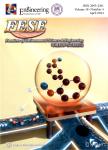Response of bioaerosol cells to photocatalytic inactivation with ZnO and TiO_(2)impregnated onto Perlite and Poraver carriers
作者机构:Environmental Science DepartmentInstitute for Scientific and Technological Research of San Luis PotosiIPICYT.Camino Presa San Jose 2055Lomas 4a SeccionCP 78216San Luis PotosiMexico
出 版 物:《Frontiers of Environmental Science & Engineering》 (环境科学与工程前沿(英文))
年 卷 期:2021年第15卷第3期
页 面:137-149页
核心收录:
学科分类:0830[工学-环境科学与工程(可授工学、理学、农学学位)] 07[理学] 070304[理学-物理化学(含∶化学物理)] 070602[理学-大气物理学与大气环境] 0706[理学-大气科学] 0703[理学-化学]
基 金:by CONACYT from the project CB-2014-01-239622.M.V.C was supported by a National CONACYT scholarship。
主 题:Immobilized catalysts Continuous flow Photocatalysis Bioaerosols Cytotoxicity Inactivation mechanism
摘 要:Bioaerosols are airborne microorganisms that cause infectious sickness,respiratory and chronic health issues.They have become a latent threat,particularly in indoor environment.Photocatalysis is a promising process to inactivate completely bioaerosols from air.However,in systems treating a continuous air flow,catalysts can be partially lost in the gaseous effluent.To avoid such phenomenon,supporting materials can be used to fix catalysts.In the present work,four photocatalytic systems using Perlite or Poraver glass beads impregnated with ZnO or TiO_(2)were tested.The inactivation mechanism of bioaerosols and the cytotoxic effect of the catalysts to^bioaeros^ls were studied.The plug flow photocatalytic reactor treated a bioaerosol flow of 460×10^(6)cells/m^(3)_(air)with a residence time of 5.7 s.Flow Cytometry(FC)was used to quantify and characterize bioaerosols in terms of dead,injured and live cells.The most efficient system was ZnO/Perlite with 72%inactivation of bioaerosols,maintaining such inactivation during 7.5 h due to the higher water retention capacity of Perlite(2.8 mL/gpcriite)in comparison with Poraver(1.5 mL/gperiite).However,a global balance showed that Ti0_(2)/Poraver system triggered the highest level of cytotoxicity to bioaerosols retained on the support after 96 h with 95%of dead cells.SEM and FC analyses showed that the mechanism of inactivation with ZnO was based on membrane damage,morphological cell changes and cell lysis;whereas only membrane damage and cell lysis were involved with Ti0_(2).Overall,results highlighted that photocatalytic technologies can completely inactivate bioaerosols in indoor environments.



